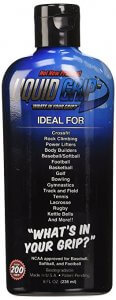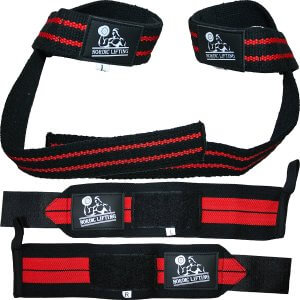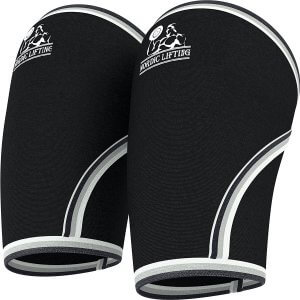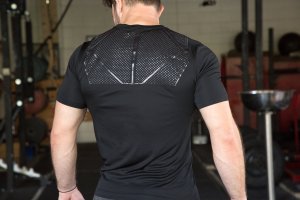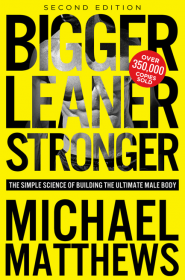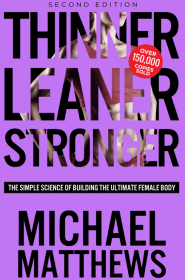The Definitive Guide on How to Bench Press (and the 8 Best Variations!)
Key Takeaways
- The bench press is one of the single best exercises for building almost every major muscle in your upper body, including your pecs, triceps, and deltoids, if you do it correctly.
- Learning how to bench press with proper form boils down to ingraining a few simple habits, and remembering a handful of effective cues (which you’ll learn below).
- The flat barbell bench press is the most common and highly regarded kind of bench press, but the incline bench press, dumbbell bench press, and reverse- and close-grip bench press can be equally effective.
Key Takeaways
- The bench press is one of the single best exercises for building almost every major muscle in your upper body, including your pecs, triceps, and deltoids, if you do it correctly.
- Learning how to bench press with proper form boils down to ingraining a few simple habits, and remembering a handful of effective cues (which you’ll learn below).
- The flat barbell bench press is the most common and highly regarded kind of bench press, but the incline bench press, dumbbell bench press, and reverse- and close-grip bench press can be equally effective.
The story of the bench press starts in 1899 with a strongman and wrestler named George Hackenschmidt.
Also known as “The Russian Lion,” Hackenschmidt was known for inventing new exercises to help him prepare for wrestling matches.
One such exercise involved getting into a position known as the “wrestler’s bridge,” then gripping a barbell and pressing it over his chest.
Here’s what it looked like:
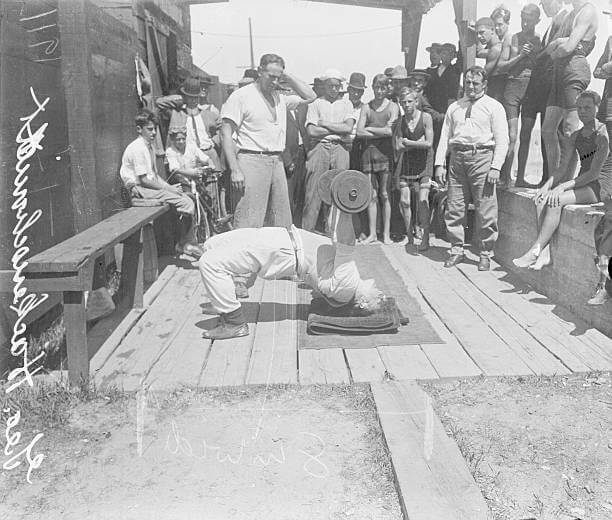
He modified the exercise slightly so that he was lying on his back instead of his neck (ouch), and then proceeded to press 362 pounds—a record that stood for 18 years.
Sooner or later someone decided to lay on a bench with the barbell suspended on pins overhead, and viola, the modern bench press was born.
“Hack,” as he was known, wasn’t just superbly strong, either. He also had one of the best physiques in the world at the time:
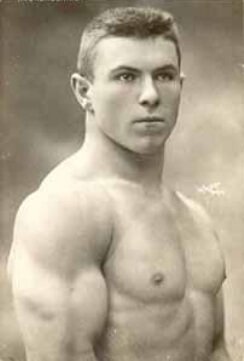
There’s a reason why every well-designed strength training program since then has included the bench press as one of its core exercises.
It’s one of the best all-around upper body exercises you can do, training the pectorals, lats, shoulders, triceps, and even the legs to a slight degree.
The bench press worked for George Hackenschmidt and now, a century later, the exercise he invented and evangelized is helping guys and gals everywhere get bigger, leaner, and stronger.
There’s just one problem.
While the bench press might seem like an artless, unsophisticated exercise, there’s a lot more going on than meets the eye.
Learning how to bench press with proper form is harder than you might think, but the rewards are well worth it.
In this article, you’re going to learn…
- What proper bench press form looks like
- How to do all of the best bench press variations
- What muscles the bench press works
- How to use a bench press calculator to decide how much weight you should use
- And more…
At the end, you’re going to get a proven, effective, and challenging bench press workout that you can start using right away.
Let’s get started.
What Is the Bench Press?
What most people refer to as the bench press is technically the flat barbell bench press.
To perform this exercise properly you need a weightlifting bench and a rack that holds the barbell over your face when you’re lying on the bench.
Here’s what this looks like:
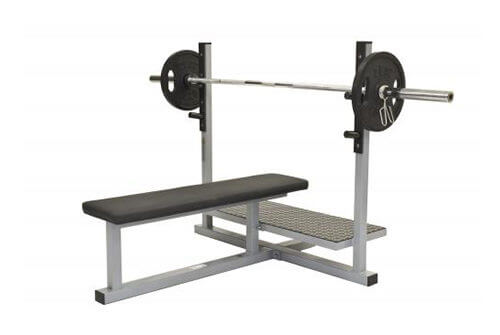
To perform the bench press, you lie on the bench, pull the bar off the rack and directly above your face, and lower it to your chest before pushing it back up toward the ceiling.
In addition to the standard bench press, though, there are many other similar variations that involve dumbbells, incline and decline benches, and machines.
Here are some of the most common variations of the flat barbell bench press:
- Incline barbell bench press. This is the same as the flat barbell bench press, except it’s performed on an incline bench instead of a flat bench.
- Dumbbell bench press. This is the same as the flat barbell bench press, except it’s performed with a pair of dumbbells instead of a barbell.
- Incline dumbbell bench press. This is the same as an incline bench press, except it’s performed with a pair of dumbbells instead of a barbell.
- Decline barbell bench press. This is the same as the flat barbell bench press, except it’s performed on a decline bench instead of a flat bench.
- Close-grip bench press. This is the same as the flat barbell bench press, except it’s performed with a grip that’s about two to three inches closer than the flat barbell bench press.
- Smith machine bench press. This is the same as the flat barbell bench press, except it’s performed using a smith machine instead of a barbell.
- Reverse grip bench press. This is the same as the flat barbell bench press, except the bar is gripped so that your palms are facing you instead of away from you.
We’ll go over all of these exercises in a moment. First, let’s look what muscles they target.
What Muscles Does the Bench Press Work?
Most people think the bench press only trains your chest. While it is an excellent chest exercise, the truth is that when performed properly, it trains almost every muscle in your body except your legs, calves, and glutes.
Specifically, the bench press helps develop your…
- Pectoralis major and minor
- Triceps
- Deltoids
- Latissimus dorsi
- Trapezius
- Forearms
The stronger you get, the more you’ll need to rely on other muscle groups to help stabilize your body, and the more of a full-body exercise it becomes.
How to Bench Press with Proper Form
Big compound movements like the bench press are double-edged swords.
They deliver the maximum muscle- and strength-building bang for your buck, but they also require good technique or they can become dangerous.
So let’s break down how to bench press step-by-step.
First, watch the first few seconds of this video to see what we’re aiming for:
[embedded content]
Here are a few things to note:
- His shoulder blades are pulled “back and down” and he never loses that tension during any part of the movement.
- His elbows aren’t too flared out to the sides or too close to his torso—somewhere in between.
- His wrists are just slightly flexed, but not folded over backwards toward his head.
- He has a gentle arch in his lower back.
- His butt stays firmly planted on the bench during every rep.
- His feet are about shoulder width apart and remain firmly in place during every rep (no wiggling from side to side).
And now let’s go through the three steps of proper bench press form, starting with the setup.
Proper Bench Press Form Step 1: Setup
Proper bench press setup comes down to getting a few things right:
- Position your body.
- Grip the bar.
- Position your feet.
- Arch your back.
- Unrack the bar.
Let’s take a closer look at each of these steps.
1. Position your body.
First, lie down on the bench and adjust so your eyes are under the bar.
Then, raise your chest up and tuck your shoulder blades down and squeeze them together. You should feel tightness in your upper back. A good cue for this is to think of pulling your shoulder blades into your back pockets.
Here’s what this looks like:
[embedded content]
Some people also like to grip the bar or even the bench before tucking their shoulder blades, because it allows them to push their back into the bench and generate more tension.
You can play around with both approaches and see what works best for you.
2. Grip the bar.
Grab the bar with your hands slightly wider than shoulder-width apart, about 22 to 28 inches, depending on your build.
If you go too narrow, you’ll shift the emphasis to the triceps as opposed to the pecs, and if you go too wide, you reduce the range of motion and effectiveness of the exercise and put more stress on your shoulders.
Hold the bar low in your hands, closer to your wrists than your fingers, and squeeze it as hard as you can. Your wrists should be bent just enough to allow the bar to settle into the base of your palm, but not folded back at a 90-degree angle. This prevents wrist pain.
Here’s how this looks:
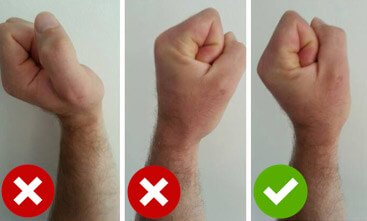
A good way to check your grip width is to have a friend get behind you (looking at the top of your head) and check the position of your forearms at the bottom of the movement. You want your forearms to be as close to perpendicular to the ground as possible. That is, straight up-and-down vertical, like this:

As you can see, the position on the far left is too wide, the middle is too narrow, and the far right is correct.
Don’t use a “thumbless” or “suicide” grip (as it’s aptly called) where your thumbs lie next to your index fingers as opposed to wrapped around the bar. The reason for this is obvious: when you’re going heavy, it’s surprisingly easy for the barbell to slip out of your hands and crash down on your chest, or worse, your throat.
3. Position your feet.
Plant your feet flat on the ground.
Start with your feet shoulder-width apart, and play around with different positions until you find one that feels most stable. Some people prefer to have their feet pulled back toward the bench (as you saw in the video above), and others prefer to have them directly underneath their knees.
If you have above-average flexibility your feet may be wider than your shoulders, like this:
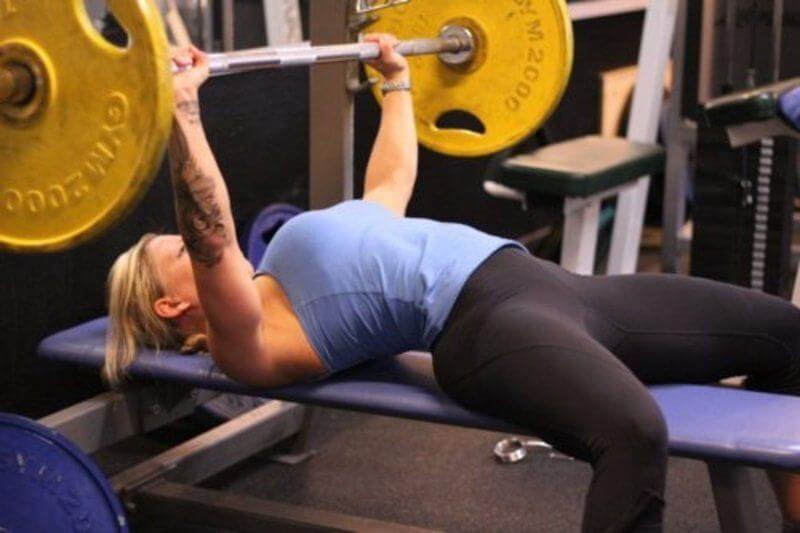
You may also see some powerlifters bench with only their tippy-toes touching the floor, like this:
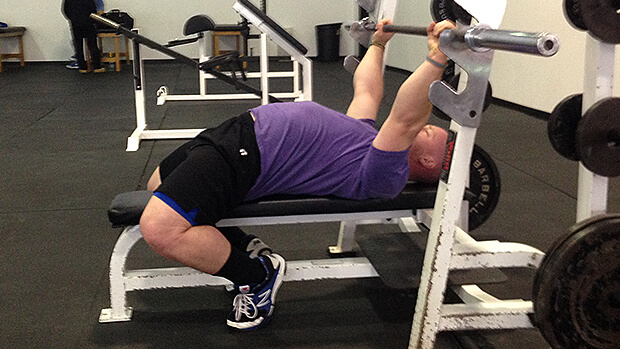
This foot position can work, too, but it’s a more advanced technique that isn’t worth experimenting with until you’ve mastered the traditional setup.
As you push your feet apart, you should feel tension in your glutes and groin.
It’s important to get this right, because during the bench press, your legs help stabilize your upper body and keep your shoulder blades positioned correctly on the bench, which allows you to use heavier weights.
As you become more experienced over time, you’ll learn to push your feet into the ground just as you begin to push the bar off of your chest, which is known as “leg drive” in powerlifting circles.
Remember to keep your legs as tight as possible during every rep. An easy way to do this is to push your knees out to the sides and push your heels into the ground as you push the bar off your chest. A common mistake is to let your knees shoot inward during your last few reps, which reduces tension in your upper body and makes it harder to finish your set.
4. Arch your back.
You don’t want your back flat on the bench and you don’t want it so arched that your butt is floating above it.
Instead, you want to maintain the natural arch that occurs when you push your chest out and your feet apart.
Here’s what that looks like:
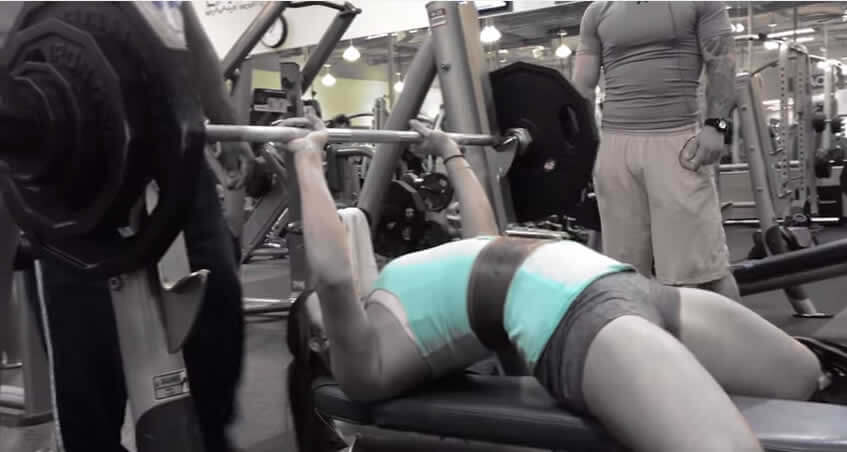
You may also see some people use an extreme “powerlifter” arch, like this:
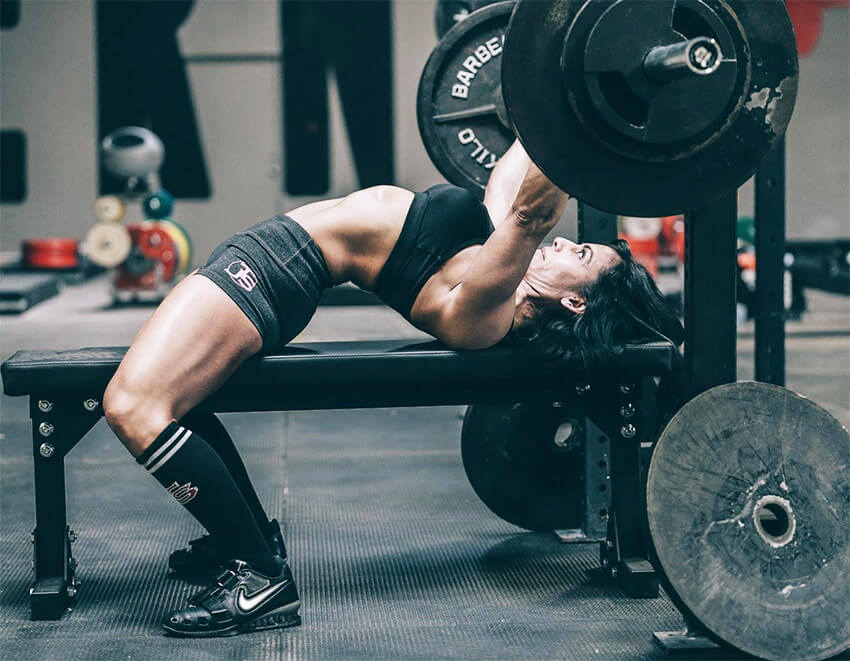
Unless you know what you’re doing, don’t try this. The reason powerlifters do this is because it reduces the distance the bar has to travel, which allows them to use heavier weights. For the rest of us, though, it isn’t necessary.
5. Unrack the bar.
Unrack the bar by locking your elbows out to move the bar off the hooks.
While keeping your arms locked, move the bar horizontally until it’s directly over your shoulders. Don’t try to bring the weight directly from the hooks to your chest, and don’t drop your chest and loosen your shoulder blades when unracking.
If you have to push the bar more than two or three inches higher than its starting position on the hooks, then you need to position the bar higher on the rack. If you have to push your shoulders upward to unrack the bar, then it’s too high and you need to position the bar lower on the rack.
Proper Bench Press Form Step 2: The Descent
The first thing you should know about the descent is how to tuck your elbows properly.
Many people make the mistake of flaring them out (away from the body), which can cause shoulder pain. This alone is probably why the bench press has a bad reputation as a shoulder wrecker. A less common mistake is tucking your elbows too close to your torso, which robs you of stability and strength and can aggravate your elbows.
Instead, you want your elbows to remain at a 50- to 60-degree angle relative to your torso throughout the entire movement. This protects your shoulders from injury and is a stable, strong position to press from. Here’s a helpful visual:
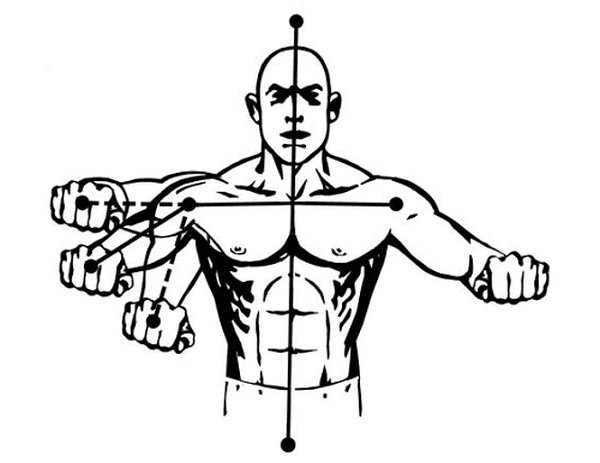
As you can see, in the bottommost position, the arms are at about a 20-degree angle relative to the torso, which is too close. The middle position is the ideal one–about 60 degrees–and the topmost is the undesirable 90 degrees.
Keeping your elbows tucked and in place, lower the bar to the lower part of your chest, over your nipples. The bar should move in a straight line down, not toward your face or belly button.
Once the bar has touched your chest (touched, not bounced off of), you’re ready to ascend.
Proper Bench Press Form Step 3: The Ascent
Although it’s called the bench press, it’s better to think of the ascent as pushing rather than pressing.
That is, picture that you’re pushing your torso away from the bar and into the bench instead of pressing the bar away from your body. This will help you maintain proper form and maximize power.
Keeping your shoulder blades down and pinched, your elbows tucked, your lower back slightly arched, your butt on the bench, and your feet on the floor, push against the bar to get it off your chest.
You can also utilize the “leg drive” I mentioned earlier by pressing your heels into the floor. This transfers force up through the hips and back, which helps maintain proper form and increase the amount of upward force you can generate.
The bar should move up with a slightly diagonal path, moving toward your shoulders, ending where you began: with the bar directly over your shoulders, where it’s most naturally balanced. Don’t allow your elbows to rise toward your ears. This makes it easier to get the weight up but makes it harder to maintain proper position for the next rep (and puts your shoulders at risk).
Lock your elbows out at the top of the movement. Don’t keep them slightly bent.
You’re now ready for the next rep.
Once you’ve completed your final rep, you’re ready to rack the bar. Don’t try to press the bar directly into the hooks because if you miss, it’s coming down on your face. Instead, finish your final rep with the bar directly over your shoulders and your elbows locked, and then slam the bar horizontally into the rack.
The 8 Bench Press Variations You Should Know
The flat barbell bench press is one of the best exercises for building all-around upper body strength and size.
If you want to emphasize certain muscles or muscle groups, though, then you can benefit from using different bench press variations.
The Incline Barbell Bench Press
The incline bench press is more or less identical to its older brother, the flat barbell bench press, except that it’s slightly better at targeting the upper chest.
You see, although there is only one major chest muscle (the pectoralis major), it attaches to the skeleton at several different points.
These “attachment points,” or “heads” of the muscle change the angle at which the muscle fibers contract, which means that some exercises are better at emphasizing different parts of the muscle than others.
In the case of the chest muscle there are two heads:
The sternal head of the pecs is what most people think of when they think of the chest muscle—the big bulging part underneath the nipple. The sternal head attaches your sternum to your upper arm and it’s responsible for bringing the upper arm closer toward the middle of your body.
The clavicular head of the pecs is a smaller strip of chest muscle that attaches the collarbone to the upper arm and it’s responsible for bringing the upper arm upward and toward the middle of your body.
As you can guess, certain movements can emphasize the main head of the pectoralis and others can emphasize the clavicular head.
Notice that I said emphasize, not isolate. That’s because all pressing movements target both heads of the chest muscle, although some are better at activating one part more than the other.
I’ve found that although the regular flat barbell bench press can help grow the upper chest, it responds best to a combination of flat and incline pressing. There are two reasons for this:
- It’s a small, stubborn muscle that takes its sweet time to grow.
- The movements that are best for developing it also happen to be great for growing the pectoralis major.
The best way to ensure your upper chest doesn’t fall behind the rest of your pec major in development is to do a lot of incline and reverse-grip pressing.
This is why you find a lot of incline pressing in the Bigger Leaner Stronger and Thinner Leaner Stronger programs—it helps maximize overall chest development. (We’ll talk more about the reverse-grip bench press in a moment).
When doing the incline bench press, the angle of incline in the bench should be 30 to 45 degrees.
I prefer 30 degrees, but some people prefer an incline closer to 45. I recommend that you try various settings ranging between 30 and 45 degrees and see which you like most. You’ll know if the angle is too aggressive if it feels like your shoulders are working significantly harder than your chest.
The basic setup and movement of the incline bench press is just as you learned for the regular bench press, with a small exception:
The bar should pass by the chin and touch just below the collarbones to allow for a vertical bar path.
Here’s a video that shows proper form with the barbell:
[embedded content]
The Close-Grip Barbell Bench Press
As I mentioned earlier, when you narrow your grip on the bar, you place more of the load on the triceps. This is undesirable when you want to focus on your chest, but it’s a great way to focus on the triceps.
At bottom, the close-grip bench press is just a regular bench press but with a closer grip. Other than the grip modification, you should perform the close-grip bench in exactly the same way as the bench press.
For your grip, your hands should be slightly (a few inches) inside your shoulders or two to three inches closer than your normal grip.
Some people place their hands just a few inches apart to try to maximize the triceps’ involvement, but this puts the shoulders and wrists in a weakened, compromised position.
If your shoulders or wrists feel uncomfortable at the bottom of the movement (when the bar is touching your chest), simply widen your grip by about the width of a finger on each side and try again. Repeat until it’s comfortable.
The Dumbbell Bench Press
The dumbbell bench press is similar to the barbell bench press, except you press one dumbbell in each hand instead of a barbell.
While it’s not a replacement for the barbell bench, it’s worth including in your program. A study from scientists at Sogn og Fjordane University College in Norway shows that the dumbbell bench press causes the same activation of the pecs, less activation of the triceps, and more activation of the biceps than the barbell bench press.
There are two main benefits of the dumbbell bench press:
- It allows you to increase the range of motion beyond the standard barbell bench press.
- It allows you to use whatever wrist position feels most comfortable to you.
There are two main downsides of the dumbbell bench press, though:
- It requires more balance, which means you can’t use as much weight as you can with the barbell bench press.
- Once you start using heavier weights, it becomes much harder to get the dumbbells into position.
Here’s how to do it properly:
[embedded content]
Incline Dumbbell Bench Press
The incline dumbbell bench press is the same as the incline bench press, except you use dumbbells instead of a barbell.
While it’s no replacement for the incline barbell bench press, it’s worth using for the same reasons that flat dumbbell bench pressing is worth using:
- It allows you to increase the range of motion beyond the standard incline barbell bench press.
- It allows you to use whatever wrist position feels more comfortable to you.
There are downsides of the incline dumbbell bench press are the same as the flat dumbbell bench press, too:
- It requires more balance, which means you can’t use as much weight as you can with the barbell bench press.
- Once you start using heavier weights, it becomes much harder to get the dumbbells into position.
Anecdotally, many people also find that doing lots of heavy, low-rep vertical and incline dumbbell pressing tends to beat up their shoulders more than barbell bench pressing, so it’s often better for higher rep work.
Here’s how I do it:
The Decline Barbell Bench Press
The decline barbell bench press is popular among some people but I’m not a fan. Thanks to its reduced range of motion, it’s just less effective than incline and flat pressing.
A common argument made for doing decline presses is working the lowest portion of the pectoralis major, but there isn’t much evidence that you need to specifically train the “lower” portion of the pecs (which are already taxed during flat barbell bench press).
The bottom line is you can never do a single set of decline bench press and still build an outstanding chest (and many do).
[embedded content]
The Reverse-Grip Barbell Bench Press
The reverse-grip bench press is an often-overlooked variation of the bench press that has merit.
It involves flipping your grip around on the bar (so your palms face you) and not only is it easier on your shoulders but it’s also as effective or more so for targeting the upper chest than the incline bench press.
The downside of the reverse-grip bench press is that many people find that it aggravates their shoulders and elbows more than the incline bench press. It doesn’t bother other people at all, though, so you’ll need to try it for yourself and see.
Here’s how to do it:
[embedded content]
Smith Machine Bench Press
The Smith machine is a weightlifting machine that involves a barbell that’s fixed into a set of vertical rails that only allows it to move straight up or down.
Because the barbell only moves in a fixed, vertical path, it doesn’t require as much skill and often allows people to use more weight.
The downside of the Smith machine bench press is that it doesn’t activate your supporting muscle groups (like your shoulders) as much as the flat barbell bench press, which makes it inferior for strength and muscle gains.
I used to do all my bench pressing on the Smith Machine and never got higher than 245 pounds for a few reps. When I first switched to the free weight bench press, I struggled with 185.
That was several years ago and I’ve since built my bench up to 295 for 2 to 3 reps. (Not outstanding by any means but respectable.)
Here’s how to do it:
[embedded content]
Bench Press Machine (Chest Press)
There are many different kinds of bench press machines, but most of them all involve pushing against one weighted lever in each hand.
Like the Smith machine, both handles are fixed so that they only move back and forth, and don’t require you to stabilize the weights.
Here’s what they typically look like:
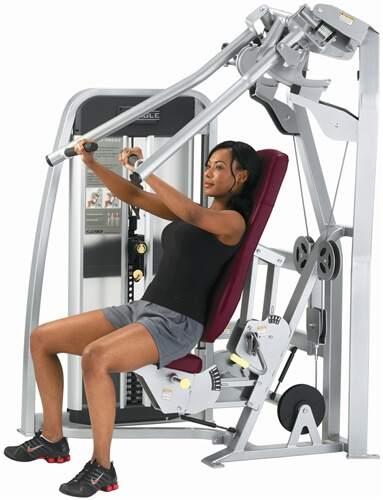
The main reason the bench press machine is popular is because it’s much easier to learn than the regular flat barbell bench press. It suffers from all of the same problems as the Smith machine, though, which is why I recommend you avoid it in favor of the barbell bench press.
If you’re confused about which bench press variation you should start with—keep things simple and stick with the flat barbell bench press. There’s a reason it’s become the king of all chest exercises, and a keystone of all good strength training programs—it works exceptionally well.
A Simple and Accurate Bench Press Calculator
Aside from bragging rights, knowing (or at least estimating) the maximum amount of weight you can bench press can actually make your training significantly more effective.
Why?
Sure, it’s fun to know how you stack up against other guys and gals, but there’s a better reason to care:
Knowing your one-rep max, as it’s called, helps you maintain optimal workout intensity (and thereby achieve optimal results).
It allows you to train hard enough to get the maximum muscle-building stimulus out of every workout, without training so hard that you increase the risk of getting injured or running into symptoms related to overtraining.
This is particularly important if you’re serious about getting stronger on the “big lifts” like the bench press where you’re moving the heaviest weights.
Now, the only surefire way to know how much weight you can bench for a single rep is to actually do it, but that comes at a cost.
A true one-rep max bench press attempt is time-consuming, risky, and exhausting.
Instead, I recommend you do what’s called a “rep-max test,” which involves doing as many reps as possible with a weight that’s slightly less than your true one-rep max.
This is much easier to prepare for and recover from, is far less dangerous, and is almost as accurate as a true one-rep max test. Once you know your rep-max, you can plug those numbers into an equation that will estimate your true one-rep max.
For example, if you bench press a weight that allows you to get five reps before reaching failure, you can then plug the weight and reps into a calculator to estimate your one-rep max.
You can read this article to learn more about exactly how to conduct a rep-max test, but here’s the gist:
Pick a weight that you’re confident you can bench press for at least three to five reps with proper form. After a thorough warm up, do as many reps as possible before reaching failure.
If you get more than 8 reps, add 10 pounds (men) or 5 pounds (women) and try again. Plug these numbers into the bench press calculator below to see how much weight you should be pressing for a certain number of reps.
| Estimated Reps and Weight Based on One-Rep Max | |||||||||||||
| Reps | 1 | 2 | 3 | 4 | 5 | 6 | 7 | 8 | 9 | 10 | 15 | 20 | |
| Brzycki | |||||||||||||
| Baechle | |||||||||||||
| dos Remedios | |||||||||||||
Bench Press Charts for Men and Women
Alright, now that you have a clear idea of how big your bench press really is, you’d probably like to know how it ranks.
Well, you can use the tables below to find out.
They come to us from Dr. Lon Kilgore and Mark Rippetoe and are based on a systematic review of decades of competitive weightlifting performance.
The following numbers are one-rep maxes, and remember that they aren’t the highest possible levels of strength, just performance benchmarks.
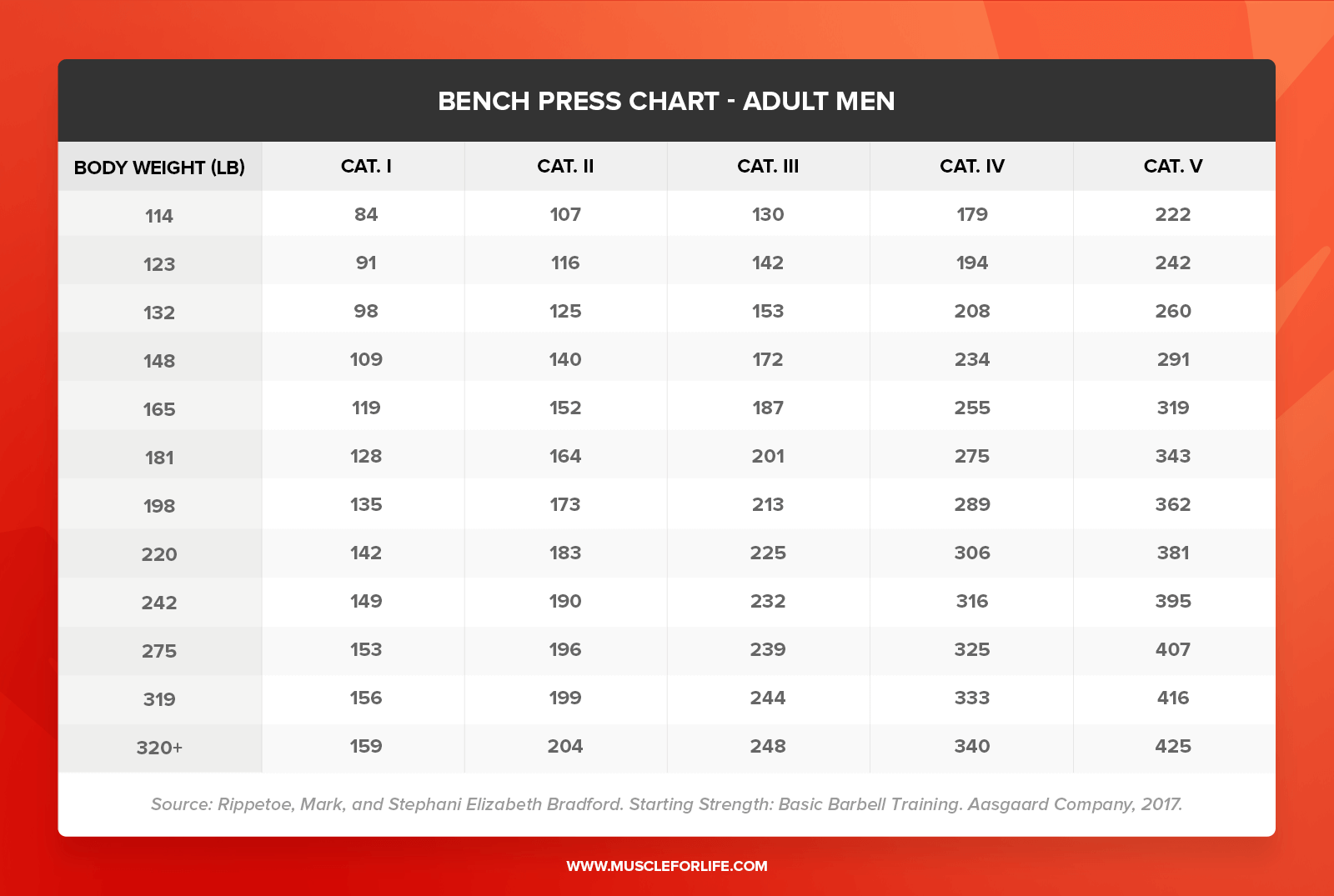
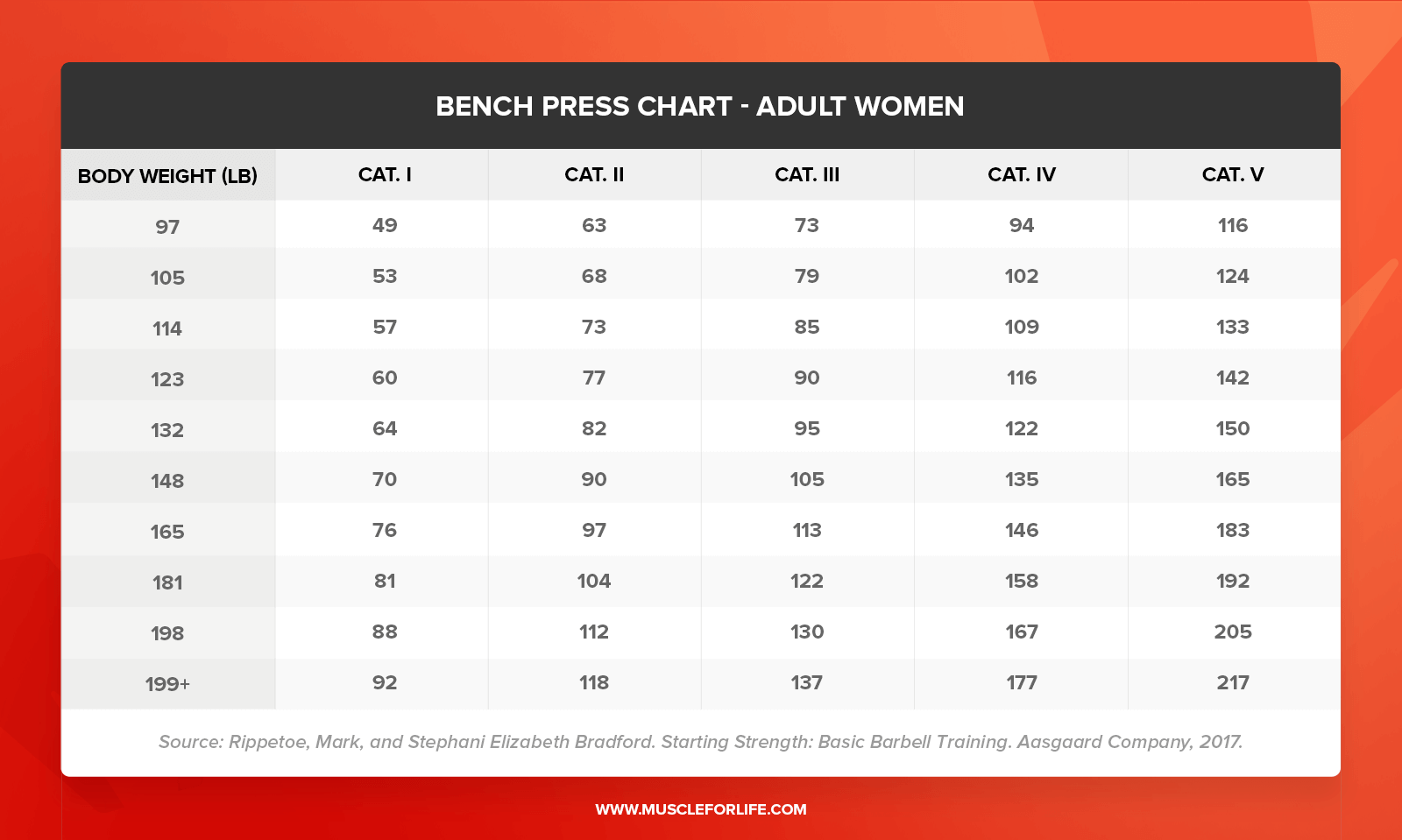
The Best Bench Press Workout
A good bench press workout focuses on heavy lifting and includes work that targets the upper portion of the pecs. Higher-rep training can be included but it should come later in the workout, after the heavy sets.
You can learn more about programming workouts in the books Bigger Leaner Stronger and Thinner Leaner Stronger, but in the meantime, you can follow the bench press workout routine below and see how it works for you.
What I want you to do over the next eight weeks is perform the following chest workout once every five to seven days:
The Best Bench Press Workout
Flat Barbell Bench Press
Warmup and three sets of…
4 to 6 reps at 80% of 1RM
Incline Barbell Bench Press
3 sets of 4 to 6 reps at 80% of 1RM
Incline Dumbbell Bench Press
3 sets of 4 to 6 reps at 80% of 1RM
Optional
Dips (Chest Version)
3 sets to failure
And a few odds and ends on how to do these workouts:
Once you hit the top of your rep range for one set, move up in weight.
This is known as “double-progression,” and it’s one of the most effective ways to ensure that you’re progressively overloading your muscles.
For instance, if you bench press 6 reps for 135 pounds, add 5 pounds to each side of the bar for your next set.
If, on the next set, you can get at least 4 reps with 145 pounds, that’s the new weight you work with until you can press it for 6 reps, move up, and so forth.
If you get 3 or fewer reps, though, reduce the weight added by 5 pounds (140 pounds) and see how the next set goes. If you still get 3 or fewer, reduce the weight to the original 6-rep load and work with that until you can do two 6-rep sets with it, and then increase.
Rest two to four minutes between each set.
The important thing is that you feel fully prepared to give your best on each subsequent set.
Yes, this is going to feel like a lot of standing around, but resting properly is a hugely important part of heavy weightlifting.
This is the time where your muscles recoup their strength so you can give maximum effort each set.
Make sure you’re eating enough food.
You probably know that you’re supposed to eat a fair amount of protein to build muscle, but total calorie intake also plays a major role as well.
Read this article to learn more.
3 Scientifically Proven Ways to Increase Your Bench Press
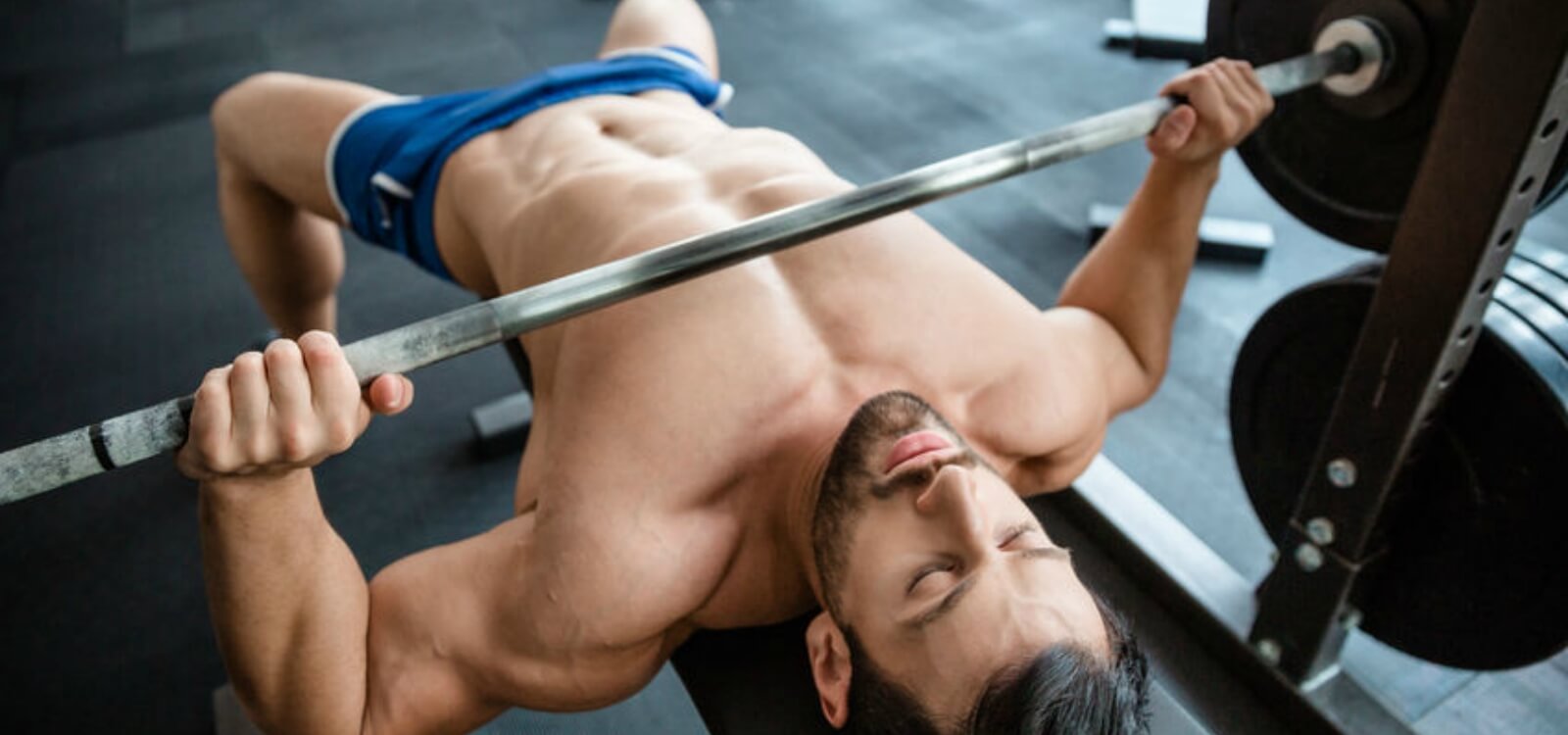
No matter what you do with your diet and workout programming, you’re going to get stuck from time to time, and especially on a big lift like the bench press.
I wish this weren’t the case, but it simply gets harder and harder to gain muscle and strength as you inch your way toward your genetic potential, and the closer you get, the more you’re going to have to break through plateaus.
That’s where these three strategies come in. They’ll not only help you break out of ruts when you fall into them, they’ll help you from getting stuck in the first place.
Keep Learning Proper Form (And Stick to it Ruthlessly)
You really can’t overemphasize proper technique when it comes to bench pressing.
It may look simple, but there’s a lot more going on than meets the eye, which is why even the world’s best weightlifters are constantly tweaking their grips, foot positions, cues, and the rest of it to improve their performance.
This is also why many people who aren’t progressing on their bench press can benefit from auditing their form.
Of course, step one would be going through the steps listed earlier in this article and making sure the first principles are in place.
It’s also helpful to have a cheat sheet of sorts with cues that reinforce proper technique. Here’s mine:
- Keep your chest up, shoulders back.
- Throw the bar into the ceiling (during the ascent).
- Spread the floor (with your feet).
- Pull the bar into your chest (during the descent).
- Crush the bar (with your hands).
It also helps tremendously to have someone video you bench pressing from several angles and then compare your reps to a model, like the video shared earlier in this article.
Look closely at how you’re moving in each phase of the bench press versus the model, make notes of what you see to be different, and work on improving them one at a time in the gym, on camera, until each becomes ingrained.
Learn to Brace Properly
“Bracing” refers to creating and maintaining tightness in your body while performing an exercise.
In weightlifting circles, this generally refers to how well you can trap air in your torso and hold it in under heavy loads.
This creates what’s known as intra-abdominal pressure, which helps stabilize your body, keep your torso rigid, and prevent the bar from moving while bench pressing.
The bottom line is you should be holding your breath during heavy bench pressing, and if you aren’t, then you aren’t going to be able to lift as much weight.
So, how do you brace properly?
Simple:
Every one to two reps, take in a breath that fills your lungs to about 80% of their maximum capacity, drawing the air deep into your stomach, press your tongue against the roof of your mouth, and don’t let that air out until you’re past the hardest part of the lift.
If you want to learn more about proper bracing and breathing while lifting, check this out:
Bench Press More Frequently
The ideal training frequency for building muscle is a heated subject. What we can know for certain, though, is this:
If you want to get better at something, you want to do it more frequently.
This applies to pretty much everything, including bench pressing. The more you bench press, the faster you’re going to improve your technique, which will translate into faster muscle and strength gain.
This is why every powerlifting program worth a hoot has you squatting, deadlifting, and/or bench pressing two to three times per week. Many bodybuilding/”aesthetic” programs, like the Bigger Leaner Stronger (men) and Thinner Leaner Stronger (women), do as well.
So, if you’re currently bench pressing once per week and are stuck, increasing frequency to bench pressing twice or even three times per week can be enough to break you out of the rut.
Keep in mind, however, that the more frequently you do an exercise—and especially a whole-body exercise like the bench press—the easier it is to run into symptoms related to overtraining.
If you want to learn more about how to increase your bench press, then you want to read this article:
→ 11 Scientifically Proven Ways to Increase Your Bench Press
The Best Bench Press Equipment
The only equipment you need to build a respectable bench press is a barbell and a bench.
That said, there are a few tools that can help you bench more weight, maintain better form, and reduce your risk of injury.
Here’s the equipment that I recommend you try:
Weightlifting Chalk
Weightlifting chalk helps by absorbing sweat and increasing the friction between your palm and the bar, and you can go with the liquid variety if you don’t want to make a mess or your gym doesn’t allow it.
If you’ve never used chalk before, I highly recommend you give it a shot.
Weightlifting Shoes
I highly recommend you pick up a pair of good weightlifting shoes.
They provide…
- A stable, hard surface to push off from
- A snug fit to keep your feet from wiggling around
- Traction to prevent your feet from slipping or shifting during a lift…
All of which saves energy, helps you maintain better form, and allows you to lift more weight.
The bottom line is the right weightlifting shoes not only improve your performance of important lifts like the bench press, squat, and deadlift, but they reduce the risk of injury as well.
Check out this article to learn more about weightlifting shoes and which ones you should get:
→ The Minimalist’s Guide to the Best Shoes for Weightlifting
Wrist Wraps
Wrist wraps are designed to provide more support for your wrists when bench and overhead pressing.
When used properly, the wraps help take some of the strain off of the tendons in your wrist, and they can also help reinforce proper bench press form by preventing your wrist from bending backward too much.
Note that wrist wraps are different from wrist straps, which are designed to wrap around the bar to improve your grip on exercises like the deadlift. Wrist wraps are cloth bands that wrap around your wrist joint, like this:
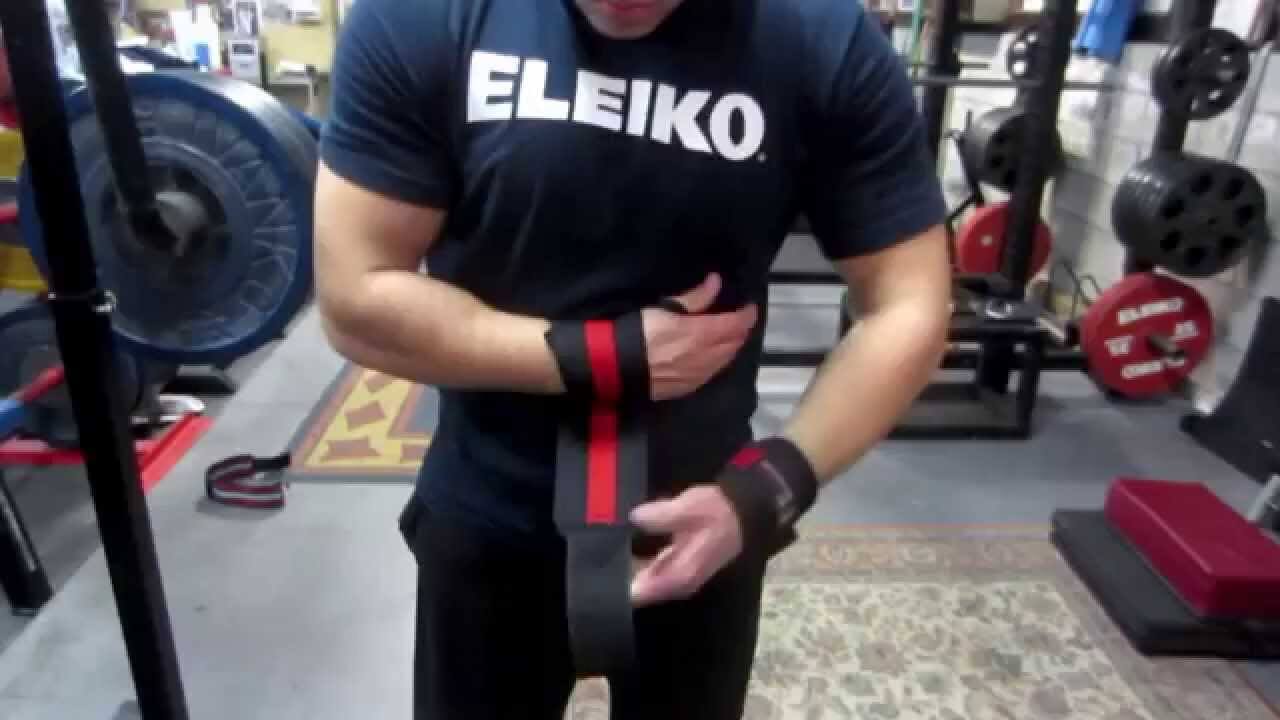
Nordic Lifting makes a good pair of wrist wraps, as does SBD.
Elbow Sleeves
Elbow sleeves provide joint support and heat retention (warmer tendons and ligaments can stretch easier) without too much compression.
Even if you don’t have any elbow problems, many people find that sleeves make heavy bench pressing more comfortable.
Nordic Lifting makes a good pair of wrist wraps, as does SBD.
Grippy Bench Shirts
One of the most common mistakes people make when bench pressing is allowing their upper body to shift out of position during their sets.
What usually happens is that as they begin to push the bar off of their chest and they let their shoulder blades slip out of position, which causes their upper body to slide backward (toward the rack). Or, one shoulder blade will slip out of position, causing their upper body to tilt to one side.
This problem is only made worse by the fact that most commercial benches are made with plastic so slippery that a baby penguin could slide on it.
As a result, a few companies have started making shirts that have a grippy, rubberized pattern around the upper back and shoulder blades to prevent the torso from shifting while bench pressing.
A few of the most popular ones include A7, Vice Grip, and Roizo.
Frequently Asked Questions About the Bench Press
What is the average weight a man can bench press?
According to the research performed by Mark Rippetoe and Ron Kilgore, the average 180-pound man who’s never bench pressed before can bench press 130 pounds.
Men who weigh less than this should be able to bench slightly less, and men who weigh more than this should be able to bench more. A good rule of thumb is that every additional 15 pounds of body weight over 150 pounds adds 10 pounds to your expected bench press.
How much should a woman be able to bench press?
According to the research performed by Mark Rippetoe and Ron Kilgore, the average 132-pound woman who’s never bench pressed before can bench press 65 pounds.
Women who weigh less than this should be able to bench slightly less, and women who weigh more than this should be able to bench more. A good rule of thumb is that every additional 10 pounds of body weight over 120 pounds adds 5 pounds to your expected bench press.
How many reps of bench press should I do?
If you want to gain muscle and strength, the most reliable way to make progress is to get as strong as possible in the 4-to-6 rep range. You can also do slightly higher reps with a lower weight sometimes, but most of your training should be with heavier weights.
What is the world record for the bench press?
The world record for the bench press is 1,075 lb (487.6 kg), which was set by Ryan Kennelly on November 8, 2008. Kennelly wore a bench press shirt, which allows you to lift more weight than you would be able to “raw,” or without any supporting equipment.
The world record for a raw bench press without a bench press shirt is 739 lb (335 kg), which was set by Kirill Sarychev on November 22, 2015.
How much does a bench press bar weigh?
A bench press bar weighs 45 pounds without any plates.
A standard bench press bar can hold a maximum of nine 45-pound plates on each side.
What should I do if I get shoulder pain when I bench press?
If you get shoulder pain when you bench press, your best bet is to avoid bench pressing for at least a week. If your shoulder still hurts when you bench press after a week of rest, switch to a different pressing exercise or stop pressing exercises altogether until your shoulder feels better.
You can learn more about how to prevent and reduce shoulder pain in this article:
What if I don’t feel my chest muscles contracting when I bench press?
If you don’t feel your chest muscles contracting when you bench press, that doesn’t mean they aren’t being trained.
When you’re huffing and puffing away under a barbell, it’s common to not feel the muscles you’re working. Or, if another weaker muscle group (like the triceps), seems like it’s doing all of the work, then that may distract you from noticing that your chest muscles are working.
The bottom line is that as you get stronger and accrue more time under the bar, you’ll get a better sense of when your chest muscles are contracting when you bench press.
What should I do if I get pinned on the bench press without a spotter?
If you end up getting pinned under the bench press, you have a few options:
- Call for help. Yes, it’s embarrassing, but it’s better than injuring yourself.
- If the weight isn’t too heavy, slide the barbell down to waist level (as if you were going to do a hip thrust). Sit up and slide the bar down to mid-thigh, then stand up and lower the bar to the ground as if you were finishing a deadlift. (Here’s a demo).
- If you don’t have safety clips on the bar, you can purposely tilt the bar to one side to allow the plates to slide off, then do the same with the other side. “Dumping the plates,” as it’s called, is also embarrassing, but it gets the job done. (Here’s a demo).
Ideally, of course, you’ll grab a spotter before doing any set where you think there’s a possibility you might hit failure.
If you can’t find a spotter and you still think you might hit failure, then I recommend you setup a bench in a squat rack and set the pins at a height that will catch the bar if you can’t finish a rep.
Here’s a good demonstration:
[embedded content]
Don’t have a squat rack and still think you might hit failure? Well, it’s time to postpone benching to a day when you can find a spotter.
Should the bar always touch your chest when bench pressing?
As a general rule, yes—you should lower the bar until it touches your chest on every rep. Here’s why:
- This provides the greatest range of motion possible, and the greater the range of motion, the more muscle-building you can expect.
- It makes it harder to compare your bench press to other people’s, since your numbers will be artificially increased.
- Should you decide to bench with a full range of motion in the future, it’s going to be much harder to add weight if you’ve been benching with a shorter range of motion for years.
As with most things, though, there are some exceptions to this rule:
- If you have shoulder issues, then you may want to experiment with only lowering the bar a few inches above your chest. This places less stress on your shoulder joint.
- If you’re playing around with some fancy bench press variations like the Spoto press, floor press, or board press which specifically call for not touching your chest on each rep. You won’t get much out of any of these exercises unless you’re already decently strong on the regular flat barbell bench press, though.
- If you have poor shoulder mobility which prevents you from touching the bar to your chest. In this case, you should work on improving your shoulder mobility until you can touch the bar to your chest.
Why do people bench with their feet on the bench?
Spend enough time in the gym, and you’ll eventually see someone benching with their feet resting on the bench instead of the floor, like this:
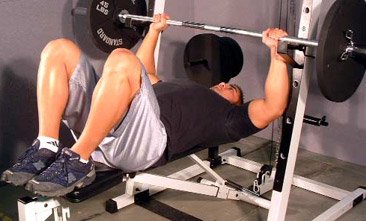
Or they’ll have their feet up in the air, like this:
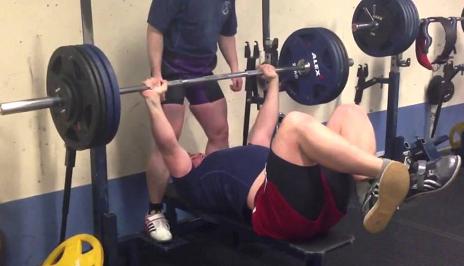
The main reason people do this is to remove the “leg drive” you learned about earlier from the equation. This forces your chest, shoulders, triceps, and core to work harder, because your legs aren’t supporting any of the load.
While this does make the exercise harder on those muscles, it also means you can’t lift as much weight, which probably cancels out most of the benefits. While there’s nothing wrong with experimenting with some feet-elevated bench press, it’s no replacement for the real thing.
I recommend you stick with the regular flat barbell bench press if your main goal is to gain muscle and strength.
What if I can’t even bench the bar yet?
If you can’t bench an empty barbell, which weighs 45 pounds, then you need to strengthen your chest, arms, and shoulders with different exercises first.
Here’s what I recommend:
Three times per week, do three sets of pushups for as many reps as you can until you hit failure. Once you can do 20 pushups for three sets, then you should be able to bench at least four to six reps with an empty barbell.
The Bottom Line on the Bench Press
The bench press is one of the most popular exercises in the world, and for good reason.
It’s one of the best exercises for targeting the chest, shoulders, and triceps, and it also helps indirectly train your lats and legs.
Proper bench press form boils down to three simple steps:
1. The Setup
- Position your body so the bar is directly above your face.
- Gripp the bar about shoulder-width apart.
- Position your feet as wide as you can while keeping them firmly planted on the ground.
- Arch your back enough to lift your chest closer to the bar and keep your shoulder blades pulled together and “down” your back.
- Unrack the bar and move it over your chest with locked elbows.
2. The Descent
- Keep your elbows tucked and in place, lowering the bar in a straight line to the lower part of your chest, over your nipples.
3.The Ascent
- Push the bar should up in a slightly diagonal path, moving toward your shoulders, ending with the bar directly over your shoulders.
- Keep your feet firmly planted during the each rep—no wiggling.
Aside from the traditional flat barbell bench press, there are also eight bench press variations you should know about:
- The Incline Barbell Bench Press
- The Close-Grip Barbell Bench Press
- The Dumbbell Bench Press
- The Incline Dumbbell Bench Press
- The Decline Barbell Bench Press
- The Reverse-Grip Barbell Bench Press
- The Smith Machine Bench Press
- The Bench Press Machine (Chest Press)
To learn how you stack up against other people in terms bench press strength, then check out the bench press charts above.
If you hit a plateau on your bench press, then make sure your technique is solid, brace properly, bench press more frequently, and test out different kinds of bench press equipment.
Finally, if you have a friend that wants to improve his or her bench press and get bigger, leaner, and stronger, please share this article on Facebook, Twitter, or wherever you like to hang out online!
What’s your take on the bench press? Have anything else to share? Let me know in the comments below!
Armistead Legge is the Editor-in-Chief for Muscle for Life and Legion Athletics. He has completed over 100 triathlons and cross-country, cycling, and adventure races, and has researched and written for over a dozen organizations, including the National Institutes of Health. When he isn’t helping people get into the best shape of their lives, he’s lifting weights, riding his bike, hiking, camping, reading, and making delicious food.
If you want a “paint-by-numbers,” step-by-step blueprint for building a muscular, lean, strong body…faster than you ever thought possible…then you want to check out my bestselling books.
Here’s a little sneak peek of what you’ll learn inside…
- The 7 biggest muscle building myths & mistakes that keep guys small, weak, and frustrated. (These BS lies are pushed by all the big magazines and even by many trainers.)
- How to build meal plans that allow you to build muscle, lose fat, and get healthy with ease…eating foods you love (yes, including those deemed “unclean” by certain “gurus”)…and never feeling starved, deprived, or like you’re “on a diet.”
- The 5 biggest fat loss myths & mistakes that keep women overweight, disappointed, and confused. (These BS lies are pushed by all the big magazines and even by many trainers.)
- An all-in-one training system that delivers MAXIMUM results for your efforts…spending no more than 3 to 6 hours in the gym every week…doing workouts that energize you, not wipe you out.
- A no-BS guide to supplements that will save you hundreds if not THOUSANDS of dollars each year that you would’ve wasted on products that are nothing more than bunk science and marketing hype.
- And a whole lot more!
The bottom line is you CAN achieve that “Hollywood body” without having your life revolve around it. No long hours in the gym, no starving yourself, and no grueling cardio that turns your stomach.
My book will show you how. Get it today and let’s build a body you can be proud of.
















